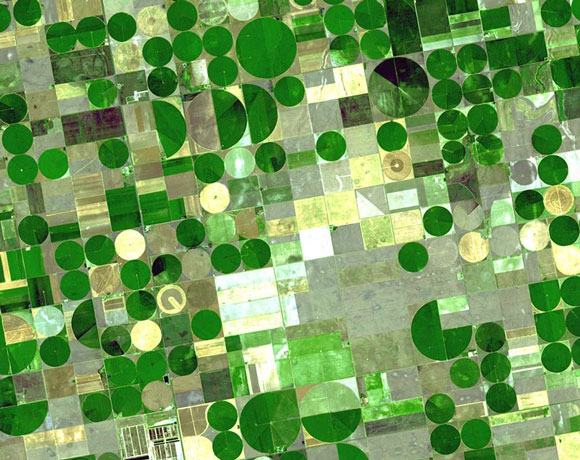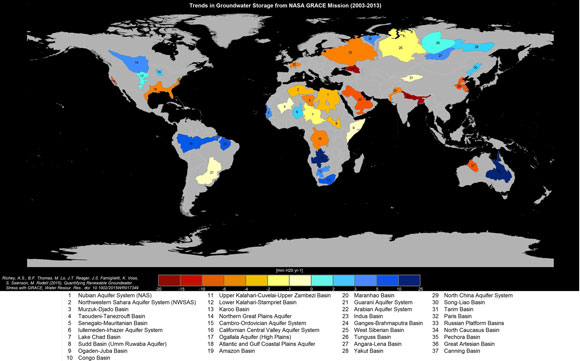
Approximately 2 billion people rely on groundwater for their primary water source, and groundwater is used to irrigate many of the crops that people depend on for food. Needless to say, groundwater is a very valuable resource. As with any valuable resource, it is a good idea to keep track of it, but that can be difficult to do with groundwater because it resides underneath the ground. Now, using new satellite technology, scientists have mapped trends of groundwater depletion in 37 of the world’s biggest aquifers—about one-third showed signs of highly unsustainable water use.
In the new study, published in Water Resources Research, the scientists used data from the GRACE (Gravity Recovery and Climate Experiment) satellite mission to assess trends in the aquifers. This mission, which began in 2002, is a joint effort between the U.S. National Aeronautics and Space Administration (NASA) and Germany’s Deutsche Forschungsanstalt für Luft und Raumfahrt (DLR). Two GRACE satellites are currently in orbit around the Earth, and like their namesake suggests, these spacecraft are measuring changes in Earth’s gravity field. Because large changes in groundwater storage can be detected with the gravity field data, these data are proving to be very valuable for creating a comprehensive picture of Earth’s underground water resources.
Of the 37 aquifers studied, 16 showed positive accumulating trends and 21 showed declining trends. The aquifers with declining trends are shown in shades of red and yellow in the map below.

Enjoying EarthSky so far? Sign up for our free daily newsletter today!
With the GRACE data and other data on groundwater recharge rates, the scientists built a renewable groundwater stress (RGS) ratio that compares the rate at which the groundwater is being used to its availability as reflected by the rate at which the aquifer is being replenished. High stress ratios are unsustainable because the usage greatly exceeds the availability.
The results showed that 7 aquifers were extremely stressed, 3 were highly stressed, 5 were moderately stressed, and 7 were lowly stressed. Only 15 aquifers had negative RGS ratios, which are indicative of sustainable use rates. Most of the unstressed aquifers were located in remote forested and rainfed regions. In contrast, many of the stressed aquifers were located in regions with high amounts of rangeland and cropland.
Alexandra Richey, lead author of the study who completed the research as a doctoral student at the University of California at Irvine, commented on the findings in a press release. She said:
What happens when a highly stressed aquifer is located in a region with socioeconomic or political tensions that can’t supplement declining water supplies fast enough? We’re trying to raise red flags now to pinpoint where active management today could protect future lives and livelihoods.
Despite the new groundwater data, scientists still aren’t quite sure how much water is left in these aquifers—they have been able to discern trends but they have not yet been able to determine the total volume that exists. That information will be critical to obtain in the years ahead.
Jay Famiglietti, a professor at the University of California and senior water scientist at NASA’s Jet Propulsion Laboratory, pressed for such research. He said:
Given how quickly we are consuming the world’s groundwater reserves, we need a coordinated global effort to determine how much is left.
Other co-authors of the study included Brian Thomas, Min-Hui Lo, John Reager, Katalyn Voss, Sean Swenson, and Matther Rodell. This study was made possible through financial support from NASA and the University of California.
Bottom line: Scientists used new satellite data to study trends in 37 of the world’s biggest aquifers and found that 10 of these are either extremely or highly stressed. The new research was published in the journal Water Resources Research on June 16, 2015.











